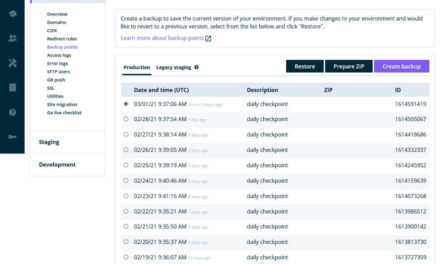This is the penultimate article in a series I’m writing on accessible web experiences. In the first article, “Why Do We Develop Accessible Web Experiences?” I discussed the “why” of accessible digital design. In “Building a Better Blueprint,” I covered creating personas, user journeys, sitemaps, and wireframes consistent with universal design principles. In “ARIA: 5 Best Practices for Screen Readers and Other Assistive Devices,” I shared techniques for making web experiences accessible for screen readers and other assistive devices. In this article I’ll offer some advice on how to discuss the importance of accessible website design with your clients.
When new or potential clients of my agency are the first to bring up website accessibility, it’s almost always for one reason: litigation. Either their company has received an ADA website accessibility complaint letter and needs rapid remediation to avoid a lawsuit, or they’ve heard about another company that received such a letter or was sued. It’s a reactionary need that we’re only discussing because the alternative is potentially costly legal action.
Otherwise, clients almost never ask about website accessibility. In the recent RFPs I’ve received for websites, not a single one has mentioned ADA compliance or accessible design, even though my agency has done some high-profile work in this area. Many specify a requirement for mobile responsive design (which should be table stakes at this point in the evolution of the web), but accessibility to all people simply isn’t addressed.
So I bring it up instead.
I believe it’s the responsibility of all digital design and development professionals to do the same.
Why discuss website accessibility with clients?
Clients come to us in search of our particular expertise. They need the value of what they know we know. But the greater value we can offer is often in illuminating their unknown unknowns.
Clients may not understand, for example, how foundational design and development decisions will impact site responsiveness, but they will certainly notice later if their site breaks on mobile or if conversions plummet on one class of device.
Unless they get a demand letter or are sued, the costs of not designing and developing a site for accessibility may also simply not be obvious, even after the fact. The site might work fine for them and the stakeholders they choose to consult during the process. If they don’t include people with disabilities in their review process, they may never realize that their site is overly difficult or impossible to use for someone with vision or hearing loss, motor impairment, or neurodivergence.
That impact is still there, though, and it’s our responsibility to help our clients see through that blindspot. I think of it as an introductory course at the intersection of empathy and UX design. We have an obligation to help everyone understand how other people may experience challenges that they do not. It’s part of our contractual obligation to give our clients our best advice and guide them toward the best solutions.
I also consider it our professional and ethical obligation to build a better web that will serve all people well with a better experience for all.
Why should your clients care about accessibility?
There are three primary reasons why your clients should care about website accessibility: It’s the right thing to do, it’s better for business, and it protects them from litigation. I present these to clients in that order, and the overarching goal is to never have to resort to the third reason. In my own experience, I rarely do.
The Right Thing to Do
One in four American adults has a disability, and unlike with most other dimensions of diversity, anyone can become disabled — whether permanently or temporarily — and find themselves in need of accessible accommodations.
Each year, we move more of our lives online, including critical services and resources, community connections, and cultural creation and participation. Denying all that to fully one quarter of the adult population would be morally unjust… an injustice that might one day directly harm even those currently without a disability.
And as I’ve written previously, accessible website design practices lead to web experiences that are better for everyone, not only for people with disabilities. It pushes us to refine how we organize information and to create clearer, frictionless paths to the most important actions.
As is often the case with design, the benefits are often invisible. People are able to find the information they need or complete the action they need to take, all without any struggle or confusion. It’s a better experience for all simply because the details of navigating the experience never get in the way.
Better for Business
The business benefits of accessible websites follow directly from the universal benefits. (That’s one good reason to lead your client conversations with why accessibility is the right thing to do.)
Why would any business want to exclude 25% of their potential customers? Why would any brand want to make it harder for customers to learn more about them or complete a purchase?
Accessible websites make a company’s website available to the largest possible potential customer base, while trimming all friction from conversions.
A commitment to accessibility also sends a message, one of a brand’s commitment to its customers — all of its customers, those with disabilities and those without. A commitment to providing a satisfying and supportive experience for all. In an era when consumers increasingly evaluate brands based on their stated and lived values, robust universal accessibility can strengthen brand loyalty too.
Protect You From Litigation
As I’ve previously written, a lack of clearly codified standards for ADA-compliant websites means there’s no ironclad guarantee that an accessible website will protect your clients from all litigation. However, hundreds of cases have established a strong precedent that gives substantial protection to any company that has followed the generally recognized best practices of accessible design.
But don’t lead with this benefit when starting the accessibility conversation with your clients. I’ve actually A/B tested this with clients: leading with “it’s the right thing to do” vs. “it’ll protect you from litigation.”
When I start with the former, nine times out of ten the clients are quickly on board. To the latter, there’s usually a follow up question: “How likely am I really to get sued?”
A client may conclude that the risk of litigation is or is not intolerably high, but that discussion starts you off down the wrong road, where accessibility is this burdensome extra cost that clients take on only to reduce their risk of a lawsuit. Contrast that with the tone of an investment they make in the future of a better web and a more profitable business.
Risk avoidance or growth: which frame around accessibility is going to lead to a better website and a more rewarding process for all? Which will leave the client feeling like they’ve invested in value rather than covered a burdensome cost of doing business?
Always try first to appeal to your clients’ better natures and the best interests of their business growth.
Why I insist on website accessibility
My commitment to all my clients is to build them brands that work: beautiful brands that serve their customers well and help them grow their businesses. I also consider it my professional obligation to make the web a little better for everyone. That’s why accessibility is so important to me.
I simply can’t serve my clients well if we ignore 25% of their customers. And I can’t fulfill my professional responsibility if I allow client indifference to overrule my ethical standards.
So I’m left with only one choice: Convince every client to do the right thing for their customers and their business by designing from day one for accessible web experiences.
Can you do any less for your clients?











